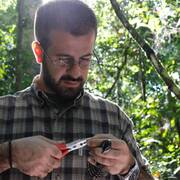DNA Barcoding for Biodiversity
A special issue of Diversity (ISSN 1424-2818).
Deadline for manuscript submissions: closed (30 September 2018) | Viewed by 24747
Special Issue Editor
Interests: integrative taxonomy; DNA barcoding; DNA metabarcoding; metazoans; diet analysis; food authenticity; high-throughput sequencing; ecosystem services
Special Issues, Collections and Topics in MDPI journals
Special Issue Information
Dear Colleagues,
The reliability of DNA barcoding relies on three main pillars which are i) a strict standardization of analytical procedures, ii) an efficient computerization of sequence data through accurate bioinformatics approaches and iii) an integration of different disciplines to provide solid reference publicly available databases for species assignation.
This special issue is devoted to the advances in DNA barcoding to address all the aspects related to biodiversity with the main goals of i) elucidating the analytical and bioinformatics advances currently available for this molecular approach; ii) defining the new frontiers of application in the context of biodiversity and biomonitoring and iii) encouraging the population of public genetic archives to also include those neglected groups of animal and plant biodiversity.
I cordially invite researchers working actively in these fields to submit their original research manuscripts to this special issue.
Dr. Andrea GalimbertiGuest Editor
Manuscript Submission Information
Manuscripts should be submitted online at www.mdpi.com by registering and logging in to this website. Once you are registered, click here to go to the submission form. Manuscripts can be submitted until the deadline. All submissions that pass pre-check are peer-reviewed. Accepted papers will be published continuously in the journal (as soon as accepted) and will be listed together on the special issue website. Research articles, review articles as well as short communications are invited. For planned papers, a title and short abstract (about 100 words) can be sent to the Editorial Office for announcement on this website.
Submitted manuscripts should not have been published previously, nor be under consideration for publication elsewhere (except conference proceedings papers). All manuscripts are thoroughly refereed through a single-blind peer-review process. A guide for authors and other relevant information for submission of manuscripts is available on the Instructions for Authors page. Diversity is an international peer-reviewed open access monthly journal published by MDPI.
Please visit the Instructions for Authors page before submitting a manuscript. The Article Processing Charge (APC) for publication in this open access journal is 2600 CHF (Swiss Francs). Submitted papers should be well formatted and use good English. Authors may use MDPI's English editing service prior to publication or during author revisions.
Keywords
- Biodiversity
- Biomonitoring
- Ecosystem services
- High Throughput Sequencing
- Environmental matrices
- Diet analysis
- Integrative taxonomy





